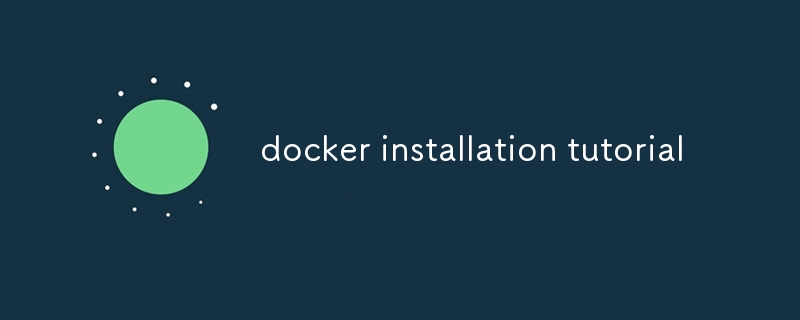docker installation tutorial
This article provides detailed instructions on installing Docker on various operating systems, including Linux, Windows, and macOS. It outlines the system requirements for Docker installation and discusses the possibility of installing Docker without

Docker Installation Guide
How to install Docker on different operating systems?
The specific steps to install Docker on different operating systems vary slightly. Here are the general steps for installing Docker on different operating systems:
-
Linux:
- Install the latest version of Docker using a package manager like apt-get (Debian/Ubuntu), yum (Red Hat/CentOS), or dnf (Fedora).
- Run commands to initiate Docker, add user to the Docker group, and start the Docker service.
-
Windows:
- Download the Docker Desktop installer for Windows.
- Run the installer and follow the on-screen instructions.
- Docker Desktop will install and set up Docker engine, Docker CLI, and Kubernetes on Windows.
-
macOS:
- Download the Docker Desktop installer for Mac.
- Run the installer and follow the on-screen instructions.
- Docker Desktop will install and set up Docker engine, Docker CLI, and Kubernetes on macOS.
What are the system requirements for installing Docker?
The system requirements for installing Docker vary depending on the operating system and Docker version. Here are the general system requirements:
- CPU: 64-bit processor
- Memory: 4 GB RAM or more recommended
- Disk space: 10 GB free space or more recommended
-
Operating system:
- Linux: Modern Linux distribution (e.g., Ubuntu, CentOS, or Fedora)
- Windows: Windows 10 or 11 with Hyper-V enabled
- macOS: macOS 10.12 or later
Can I install Docker without administrator privileges?
Yes, it is possible to install Docker without administrator privileges using a tool called Moby. Moby is a lightweight version of Docker that can be installed as a non-root user. However, certain features and functionality may require root privileges.
The above is the detailed content of docker installation tutorial. For more information, please follow other related articles on the PHP Chinese website!

Hot AI Tools

Undresser.AI Undress
AI-powered app for creating realistic nude photos

AI Clothes Remover
Online AI tool for removing clothes from photos.

Undress AI Tool
Undress images for free

Clothoff.io
AI clothes remover

Video Face Swap
Swap faces in any video effortlessly with our completely free AI face swap tool!

Hot Article

Hot Tools

Notepad++7.3.1
Easy-to-use and free code editor

SublimeText3 Chinese version
Chinese version, very easy to use

Zend Studio 13.0.1
Powerful PHP integrated development environment

Dreamweaver CS6
Visual web development tools

SublimeText3 Mac version
God-level code editing software (SublimeText3)

Hot Topics
 1392
1392
 52
52
 36
36
 110
110
 Docker Interview Questions: Ace Your DevOps Engineering Interview
Apr 06, 2025 am 12:01 AM
Docker Interview Questions: Ace Your DevOps Engineering Interview
Apr 06, 2025 am 12:01 AM
Docker is a must-have skill for DevOps engineers. 1.Docker is an open source containerized platform that achieves isolation and portability by packaging applications and their dependencies into containers. 2. Docker works with namespaces, control groups and federated file systems. 3. Basic usage includes creating, running and managing containers. 4. Advanced usage includes using DockerCompose to manage multi-container applications. 5. Common errors include container failure, port mapping problems, and data persistence problems. Debugging skills include viewing logs, entering containers, and viewing detailed information. 6. Performance optimization and best practices include image optimization, resource constraints, network optimization and best practices for using Dockerfile.
 Docker Volumes: Managing Persistent Data in Containers
Apr 04, 2025 am 12:19 AM
Docker Volumes: Managing Persistent Data in Containers
Apr 04, 2025 am 12:19 AM
DockerVolumes ensures that data remains safe when containers are restarted, deleted, or migrated. 1. Create Volume: dockervolumecreatemydata. 2. Run the container and mount Volume: dockerrun-it-vmydata:/app/dataubuntubash. 3. Advanced usage includes data sharing and backup.
 How to exit the container by docker
Apr 15, 2025 pm 12:15 PM
How to exit the container by docker
Apr 15, 2025 pm 12:15 PM
Four ways to exit Docker container: Use Ctrl D in the container terminal Enter exit command in the container terminal Use docker stop <container_name> Command Use docker kill <container_name> command in the host terminal (force exit)
 How to update the image of docker
Apr 15, 2025 pm 12:03 PM
How to update the image of docker
Apr 15, 2025 pm 12:03 PM
The steps to update a Docker image are as follows: Pull the latest image tag New image Delete the old image for a specific tag (optional) Restart the container (if needed)
 How to restart docker
Apr 15, 2025 pm 12:06 PM
How to restart docker
Apr 15, 2025 pm 12:06 PM
How to restart the Docker container: get the container ID (docker ps); stop the container (docker stop <container_id>); start the container (docker start <container_id>); verify that the restart is successful (docker ps). Other methods: Docker Compose (docker-compose restart) or Docker API (see Docker documentation).
 Docker Security Hardening: Protecting Your Containers From Vulnerabilities
Apr 05, 2025 am 12:08 AM
Docker Security Hardening: Protecting Your Containers From Vulnerabilities
Apr 05, 2025 am 12:08 AM
Docker security enhancement methods include: 1. Use the --cap-drop parameter to limit Linux capabilities, 2. Create read-only containers, 3. Set SELinux tags. These strategies protect containers by reducing vulnerability exposure and limiting attacker capabilities.
 How to copy files in docker to outside
Apr 15, 2025 pm 12:12 PM
How to copy files in docker to outside
Apr 15, 2025 pm 12:12 PM
Methods for copying files to external hosts in Docker: Use the docker cp command: Execute docker cp [Options] <Container Path> <Host Path>. Using data volumes: Create a directory on the host, and use the -v parameter to mount the directory into the container when creating the container to achieve bidirectional file synchronization.
 How to view the docker process
Apr 15, 2025 am 11:48 AM
How to view the docker process
Apr 15, 2025 am 11:48 AM
Docker process viewing method: 1. Docker CLI command: docker ps; 2. Systemd CLI command: systemctl status docker; 3. Docker Compose CLI command: docker-compose ps; 4. Process Explorer (Windows); 5. /proc directory (Linux).




